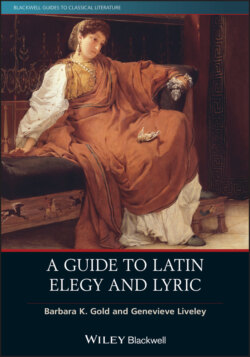Читать книгу A Guide to Latin Elegy and Lyric - Barbara K. Gold - Страница 14
Cultural, Political, and Historical Contexts for Elegy and Lyric: Time and Place
ОглавлениеIn Kristen Ehrhardt’s useful formulation, the space in which Latin lyric situates many of its poems is “a mixed place” (Ehrhardt 2018). It typically blends together aspects of both Greece and Rome, city and countryside, the Greek symposium and the Roman banquet (convivium). Gardens, groves, fields, and forests provide a largely rural background for Horace’s Odes (sometimes pastoral, sometimes bucolic) although the characters who inhabit this space often seem to be slightly out-of-place in this Arcadian landscape – as if they are temporary visitors from the city rather than permanent residents.
In contrast, elegy predominantly stages its scenes and places its poetry within the physical and cultural context of the city (see Welch 2005; Harrison 2013). Its backdrop is contemporary Augustan Rome, and the lifestyles it represents are distinctly urban – and even urbane. Some scholars have characterized Latin love elegy as “pastoral in city clothes” (Veyne 1988: 101–115). But this description is misleading. It’s true that Tibullus often fantasizes about a simple life in the countryside, but the great majority of his elegies are actually based in the city (the rural exceptions are 1.1, 1.3, 1.10, 2.1, and 2.3). Sulpicia, too prefers the city to the countryside and complains loudly when her uncle plans to take her out of Rome to stay at his country house (3.14 and 3.15). For all of the elegiac poets, the city of Rome is the place to be. Propertius and Ovid even take recognizable Roman landmarks and use them to set the scene in their poems. Propertius (2.31.1–2) complains that he is late for a date with his puella (his girlfriend Cynthia) because he has been delayed en route by the ceremonial opening of the porticoes of Augustus’ restored temple of Palatine Apollo. He wryly advises Cynthia that Pompey’s portico offers the perfect environment for her to flaunt her charms (2.32.11–16) – but also suggests some of Rome’s other famous parks and gardens, porticoes, and colonnades, as places where puellae and their lovers like to hang out (2.23.5–6; see also 4.8.75–6). Ovid’s Amores and Ars Amatoria similarly recommend a variety of places in the city that are suitable for romantic and erotic encounters. Indeed, Ovid seems particularly (and cheekily) keen on landmarks that have a special connection with Augustus and the imperial family: he recommends various “pick-up” spots throughout the city of Rome (Ars Amatoria 1.67–170), and recommends the Palatine portico of the Danaids (Amores 2.2.3–4) and the Circus Maximus (Amores 3.2). But he also points out to those interested in an illicit affair al fresco the porticoes of Octavia and Livia (Ars Amatoria 3.391) as particularly good spots to pick up a lover.
Alongside these recognizable spatial markers for their poetry, the Roman elegists also use specific temporal markers. Identifiable historical events and dates are sometimes mentioned (e.g., the Augustan marriage laws, the Secular Games), and a few elegies represent what is known as “occasional poetry,” celebrating a particular event such as a promotion, or a birthday (Tibullus 2.2, Propertius 3.10, Sulpicia 3.14 and 3.15). The combined effect of these features is to offer the impression that elegy represents reality, that the elegiac world is a mirror to the “real world” of Augustan Rome (see Kennedy 1993: 92–93). And, although we should see this reality effect for what it is (or rather, for what it is not), this phenomenon does invite us to look outside the poetry, to consider the wider historical and social world in which the ostensibly private and personal world of elegy is situated. Indeed, there are a number of ways in which lyric and elegy respond to the socio-cultural contexts in which they are produced, and the treatment of two themes are of particular importance to our understanding of these genres: rei publicae (politics) and puellae (girls).
